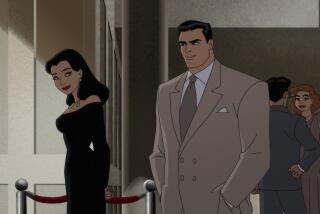Drawing on anxiety
- Share via
BRIGHT, airy, comfortable and cheery -- these are not the first words one would think to use when describing either ‘50s-modern architecture or the work of Bruce Eric Kaplan. And yet there he is on a recent afternoon, casually padding in sock feet around the sun-kissed living room of his Westside home, a historic structure designed by noted architects A. Quincy Jones and Whitney Smith as his wife and infant child await in another room
Droll and dry, Kaplan is known as a writer for such anxiety-drenched television shows as “Seinfeld” and “Six Feet Under” (where he also became an executive producer) while alternately achieving success with his offbeat cartoons for the New Yorker signed with the distinctive block-lettered “BEK.” He has published numerous books, including “The Cat That Changed My Life” and his most recent, “Every Person on the Planet,” about a couple who see their holiday party guest list swell to include the entire world population.
I just assumed you lived in New York. Are people often surprised to find you live in Los Angeles?
Sometimes. It’s a very urban, New York sensibility. One identity is as a television writer, which is very classically Southern California, but another of my personae is as a New Yorker cartoonist. Why wouldn’t someone think a New Yorker cartoonist lives in New York? It seems like a natural thing, although about a third of the cartoonists don’t. At least three live in Los Angeles.
The holidays are such a perennial as far as topics for humor go. What made you want to do something based on the holidays?
I think the word “holidays” appears only once. It’s more about parties. It’s a holiday book for people who are not looking for a holiday book. Or, in my case, it’s a holiday book for people who never celebrated the holidays. We watched TV or went to the movies. We’d have Hanukkah for about five minutes each night and move on. It wasn’t a big thing.
Have you had any particularly embarrassing moments giving a party?
I’ve had mostly book parties, where I get very focused on inviting everyone and not forgetting anyone, although of course one always does, and being worried no one will show up, but mostly the book comes from going to parties and feeling very, for lack of a better word, anxious. Even talking about it, I get terrified. It’s like going onstage and being judged -- whether you’re giving one or going to one. I remember being in the car going to a friend’s house for a party and just being filled with this utter anxiousness. A house full of my friends just filled me with fear.
Do you see a connection between your work for television and your cartoons? Do they come from the same place?
I see them as connected by where they come from inside of me. Creative stuff hopefully comes from your unconscious and all that, so when it’s working it comes from outside of oneself. You start from yourself, “What did I do last night? What am I thinking about?” Hopefully, if you try hard enough it then takes on a life of its own.
In television writing, you want to hear what the characters say as opposed to giving them something to say. It’s the same with the cartoons. You hear what these people or fish or animals say rather than putting it in their mouths. So that’s very similar. As far as my experience of both endeavors, that’s very different. In terms of a television producer versus being a cartoonist, it’s like two different lives. My cartoon life is in my office, and it’s very separate and getting very in my own head. My television life is I’m begging one of the actors to say the line in the way I’d like them to.
Do you consider one more personal than the other?
It’s like Batman and Bruce Wayne. Not to glorify myself, but it’s two different identities. It’s like being a dry cleaner and a nanny. There’s not a lot of overlap in terms of the worlds. No one who knows me as a New Yorker cartoonist also knows me as a TV writer, and vice versa.
Not to belabor the analogy, but which is which?
You know the answer to the question. Bruce Wayne is the producer, Batman is the cartoonist, because the cartooning is done under cloak of darkness, all by myself. The television thing is out in the world interacting with everyone.
It’s interesting that there is this sense of untethered disgruntlement in your cartoons, yet it’s not expressed in a direct way like in Harvey Pekar’s work or even on “Seinfeld” but by way of a more abstracted version of whatever it is that’s bothering you.
That seems accurate. But what do I say now? I think you’ve said it.
More to Read
Sign up for our Book Club newsletter
Get the latest news, events and more from the Los Angeles Times Book Club, and help us get L.A. reading and talking.
You may occasionally receive promotional content from the Los Angeles Times.







